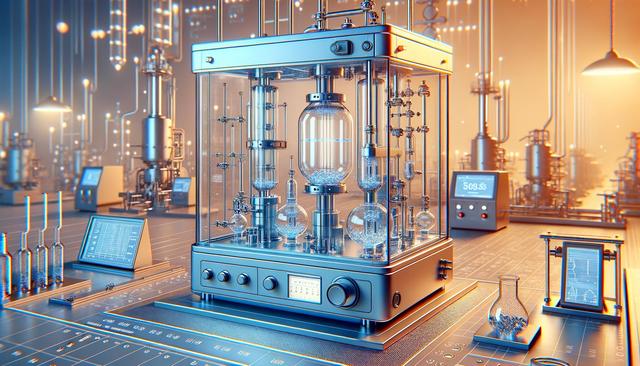Understanding the Basic Principles of Glass Calorimeter Machines
Glass calorimeter machines operate on the fundamental principle of energy conservation. When a physical or chemical process occurs inside the calorimeter, the energy released or absorbed is transferred as heat, which causes a detectable temperature change. Because these machines are constructed with glass, they allow clear visibility of the contents while providing the necessary insulation to minimize heat exchange with the external environment. This ensures that the heat measured is primarily from the process itself, not from ambient interference. The glass material also resists most chemical reactions, making it suitable for various types of experiments.
The most widely used principle in these machines is based on specific heat capacity. By knowing the mass of the substances involved and measuring the temperature change, the amount of heat (q) can be calculated using the formula q = mcΔT. In this equation, ‘m’ represents mass, ‘c’ is the specific heat capacity, and ‘ΔT’ is the temperature difference. This fundamental approach is applicable in both educational and research settings, providing a solid foundation for understanding thermodynamic behavior.
Types of Processes Studied with Glass Calorimeters
Glass calorimeter machines are versatile tools used across a range of scientific investigations. They play a significant role in analyzing both exothermic and endothermic reactions. These machines help researchers quantify heat changes in various processes, including:
- Chemical reactions such as neutralization or combustion
- Physical changes like melting, freezing, or dissolving
- Heat transfer between substances with different temperatures
In academic laboratories, students often use glass calorimeters to study basic principles of energy exchange. In industrial settings, these machines are employed to evaluate the thermal properties of materials or to monitor the heat behavior during manufacturing processes. Their adaptability supports a wide range of applications, from small-scale educational experiments to precise, large-scale industrial testing.
Construction and Components of Glass Calorimeter Machines
The structure of a glass calorimeter machine is specifically designed to maintain thermal integrity while allowing visual observation. The typical components include:
- An inner glass chamber that holds the sample or reaction mixture
- Insulating layers or vacuum-jacketed walls to prevent external heat exchange
- A lid with ports for thermometer insertion and reagent addition
- Stirring mechanisms to ensure uniform temperature distribution
These features work together to ensure that the heat measured is as accurate as possible. The transparency of glass makes it easy to observe color changes or phase transitions during reactions, which is particularly useful in educational demonstrations. Additionally, the inert nature of glass helps prevent contamination or unwanted side reactions, making it a reliable choice for sensitive experiments.
Advantages and Limitations of Using Glass Calorimeters
Glass calorimeter machines offer several advantages that make them a popular choice in thermodynamic experiments. Some of the main benefits include:
- Visual transparency for easy monitoring of reactions
- High chemical resistance to a wide range of substances
- Effective insulation to minimize heat loss
- Reusable and durable with proper care
However, there are also limitations to consider. Glass is fragile and can break under sudden temperature changes or mechanical stress. Additionally, while glass calorimeters are excellent for moderate heat processes, they may not be suitable for extremely high-temperature reactions that require specialized materials. Maintenance and cleaning also need to be done with care to avoid scratches or residues that could affect readings.
Despite these constraints, the benefits often outweigh the drawbacks, especially in controlled environments where the risk of thermal shock and physical damage is minimized. Their balance of visibility and insulation makes them a valuable tool in both teaching and research settings.
Applications in Research and Industry
Glass calorimeter machines are widely utilized in both academic and industrial research to study thermal behavior and energy exchange. In chemistry laboratories, they are instrumental in determining enthalpy changes and reaction kinetics. In materials science, they help in evaluating the thermal stability and specific heat of new compounds. Furthermore, industries involved in pharmaceuticals, food processing, and polymers benefit from calorimetry data to optimize production processes and ensure quality control.
Some specific applications include:
- Monitoring heat release in pharmaceutical drug formulation
- Analyzing nutritional content through combustion reactions
- Understanding energy profiles in polymer curing processes
- Studying biochemical reactions, including enzyme kinetics
These machines contribute valuable insights that allow scientists and engineers to make informed decisions about material properties, process efficiency, and product safety. With advances in digital integration, modern glass calorimeters now often include automated data logging and temperature control, further enhancing their precision and usability.
Conclusion
Glass calorimeter machines play a crucial role in the study and application of thermodynamics across various fields. Their ability to provide accurate heat measurements in a transparent, chemically inert environment makes them especially useful in both educational and industrial contexts. While they do have limitations, such as fragility and thermal range, their overall reliability and effectiveness continue to make them a preferred choice for controlled heat analysis. For researchers, educators, and engineers alike, understanding and utilizing glass calorimeter machines can significantly enhance the quality and depth of thermal investigations.




Leave a Reply